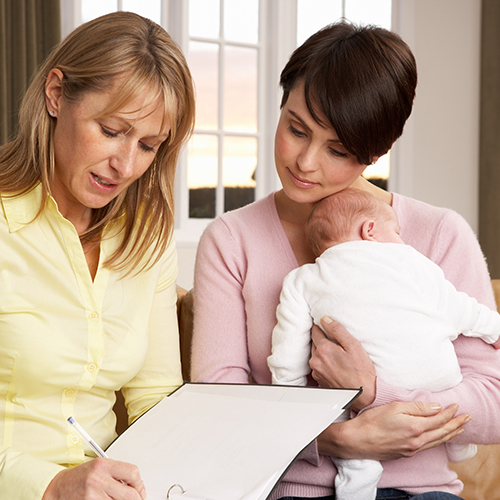19 June 2020
 Call The Midwife is one of the most loved shows on television, regularly watched by a global audience of 11 million, and if the latest evidence from South Australia is any guide, increasing numbers of pregnant women are now heeding the call.
Call The Midwife is one of the most loved shows on television, regularly watched by a global audience of 11 million, and if the latest evidence from South Australia is any guide, increasing numbers of pregnant women are now heeding the call.
The highly successful British series is set in the 1950s, but a new paper released this month by UniSA researchers shows how midwifery is helping to shape 21st century healthcare in our own state.
Almost 20 per cent of women in South Australia now receive antenatal care through publicly-funded midwifery-led services and 15 per cent of women in SA give birth entirely through midwifery care.
According to Pam Adelson, lead author of a UniSA study documenting two decades of midwifery-led care in SA, the preference for midwives has more than doubled since 1998 when birth centres (BC) were first established in South Australia.
It’s a big thumbs up for midwives and while the three existing birth centres in Adelaide can’t meet the growing demand with just 10 beds, all women are able to receive midwifery-led care throughout their pregnancy, birth and afterwards.
“Six per cent of South Australian women give birth each year in one of the three midwifery-led birth centres in SA,” Adelson says. “Even though this is higher than the national average (2 per cent), more women could opt for midwifery-led births if we adopted national recommendations to provide additional birth centres.”
While the overall number of BC births has not increased, women seeking midwifery-led care throughout their pregnancy continues to grow.
The preference for midwives crosses all cultures, the study finds, with women from non-English speaking backgrounds just as likely to choose a birth centre as Australian-born women.
Adelson, who is based at UniSA’s Rosemary Bryant AO Research Centre, says the benefits of midwifery-led care are widely recognised, with multiple studies reporting higher maternal satisfaction, with lower costs to health services and fewer interventions. There are also no significant differences in adverse outcomes compared to conventional births in labour wards.
“Obstetricians work collaboratively with midwives and are needed for pregnant women who have complex health needs, however for the majority of healthy women, professionally-educated midwives offer a highly valued service,” she says.
“This has been especially true during the COVID-19 pandemic, which saw the cancellation of antenatal classes and restrictions to hospital clinic visits, leaving many women feeling vulnerable.
“Having a known midwife providing continuity of care throughout the pregnancy, birth, and afterwards, has provided a lot of reassurance to women using this service in recent months,” Adelson says.
The researchers used 19 years of SA Health perinatal collection data and birth statistics in midwifery-led models of care to assess the trends and characteristics of women using these services.
Women opting for midwifery-led births in BC from 1998 to 2016 were younger than those birthing in conventional labour wards and less likely to be having their first birth.
Obstetric complications were reported for 12 per cent of women birthing in BC compared with 35 per cent of women birthing in conventional labour wards.
Most births in Australia (97 per cent) still occur in hospitals in conventional labour ward settings, with only 2.4% of women giving birth in a midwifery-led BC or at home (0.38%).
“This proportion has remained static with approximately 2 per cent of women giving birth in BC over the last 20 years in Australia. For many years, South Australia had the highest recorded proportion of BC births in the country at approximately 6 per cent, although the ACT has surpassed that figure since 2014, with a comparable figure of 7-8 per cent.”
The researchers found that, on average, over the study period, 11 per cent of women in South Australia intended to give birth at midwifery-led birth centres, although only 5.9 per cent did so. The reasons included lack of available beds and complications during the course of their pregnancy.
“Nationally, the number of birth centres in Australia has decreased in the past two decades, despite women wanting more choice over their birth place. This goes against the trend in some other countries, such as the Netherlands and the United States, where birth centres are increasing. Hopefully Australia can follow suit,” Adelson says.
Notes for editors
“Two decades of Birth Centre and Midwifery-led care in South Australia, 1998-2016” has been published in Women and Birth. The authors are Pam Adelson, Associate Professor Lois McKellar, Dr Julie Fleet and Professor Marion Eckert, all from the University of South Australia.
Case study: Journalists are welcome to interview Adelaide mother Lisa Mundy, who birthed at Lyell McEwin’s birth centre during COVID-19 and had midwifery care throughout her pregnancy. To make contact with Lisa and for a copy of the paper, please email candy.gibson@unisa.edu.au
Media contact: Candy Gibson office +61 8 8302 0961 mobile: +61 434 605 142
email: candy.gibson@unisa.edu.au
Lead researcher: Pam Adelson office: +61 8 8392 1475 mobile: +61 401 193 809
email: pam.adelson@unisa.edu.au



